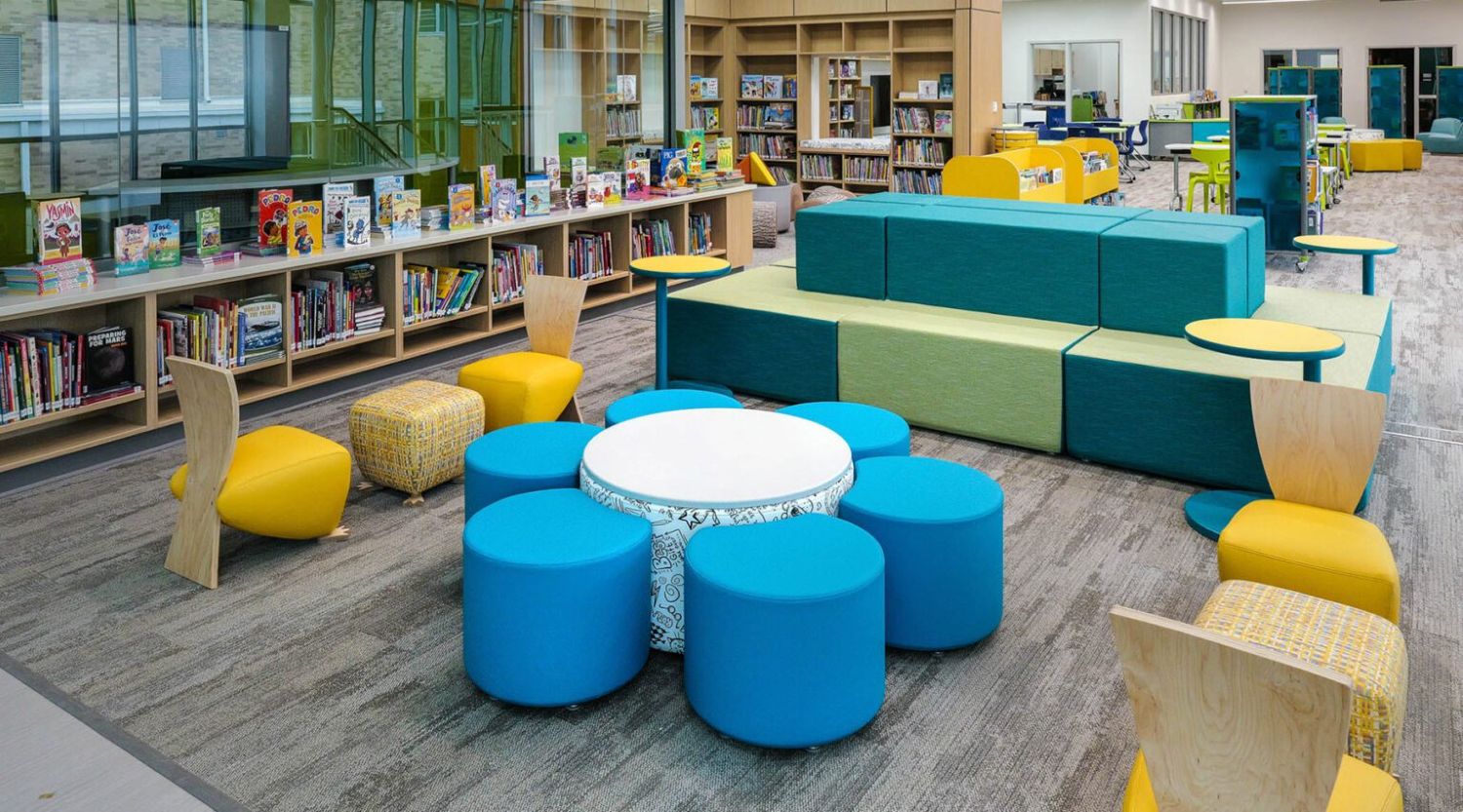On the surface, libraries are a hub for information, but perhaps they’re more specifically a place for connecting people to that information. A well-designed media center fosters literacy, sparks curiosity, and gives people the tools to think critically and independently. And this is especially important for K-12 students.
Research has long shown that libraries and media centers are a direct driver of student success. As stated by the Center for American Progress, “More than 50 years of research across more than 60 studies show that students with access to well-resourced school libraries with certified librarians consistently perform better academically and score higher on standardized assessments.”
Libraries are clearly instrumental in education. But as teaching and learning continue to evolve, these spaces need adapt as well to facilitate new ways students learn, engage, and grow on campus.
Why Libraries and Media Centers Need Updating
Despite their clear importance, many school libraries haven’t kept pace with how learning happens today. The way students gather and digest information has changed. What was once exclusively in textbooks has shifted to tablets. Where quiet study once defined the library experience, collaboration and creativity now take center stage. Yet, many libraries and media centers still reflect designs meant for a now-obsolete era.
Today’s learners engage through group projects, multimedia assignments, and hands-on exploration. They need spaces that flex with them, places where students might read a novel in one corner and collaborate on a digital slideshow in another.
Many districts are recognizing this and renovating their media centers with furniture and technology that align with 21st-century learning goals. They’re setting out to create flexible, inspiring environments that better meet the needs of today’s students.
Designing the Modern Media Center
When you imagine a modern library or media centers, you should of think movement, flexibility, and student choice.
The most effective spaces share several design characteristics:
- Flexible Furnishings: Soft seating, modular desks, and movable shelving create comfortable, adaptable spaces that can be easily reconfigured to support independent study or small-group collaboration.
- Collaborative Zones: Media centers now include huddle spaces where students can brainstorm, design interactive digital stories, or edit videos together, supporting the future-ready skills that today’s classrooms should emphasize.
- Technology Integration: Technology is now woven into nearly every part of students’ lives. Libraries need to support that reality with reliable charging access, touchscreen displays, and digital resources that complement the print collection.
- Multi-Use Areas: Spaces designed to function as study zones, presentation areas, and gathering spots provide versatility for students to focus individually, collaborate in small groups, or engage in larger community activities as needed.
- Community Connection: Media centers serve the wider school community, hosting events, parent meetings, and workshops that bring students, families, and educators together in a shared environment.
- Scalable & Future-Ready: Modular furniture, mobile storage, and tech-forward infrastructure to ensure the space can adapt as student needs and technologies change.
Library and media center design should look beyond the aesthetic and be strategic. Every decision, from seating type to lighting, communicates what kind of learning the space values. When done well, it signals to students that curiosity and creativity are welcome here.
Supporting Instruction for Librarians, Students, and Educators
While the needs of the physical space have changed, we also must recognize that the librarian’s role has evolved dramatically. Modern librarians are instructional partners, teaching students how to evaluate sources, think critically, and use technology responsibly. Outdated environments can hold them back, but updated libraries help them expand their impact.
A redesigned media center gives librarians more tools to support instruction and foster inquiry-based learning. With flexible layouts, librarians can shift between teaching small groups, supporting independent study, and co-teaching with classroom educators.
These benefits are tangibly transferred to students. In addition to the above reference to Center for American Progress, it’s also noted by Phi Delta Kappan that “Graduation rates and test scores in reading and math were significantly higher in schools with high-quality libraries and certified librarians, even after controlling for school size and poverty.”
And of course, for teachers, the updated media center becomes an extension of the classroom, a place for interdisciplinary projects and creative collaboration. It provides space for small-group work, differentiated instruction, and student choice — all proven means of boosting engagement.
Seeing the Change in Action
You can witness the effects of modernization at Sligh Middle School in Tampa, Florida, where a recent media center renovation has become a source of pride and inspiration for students. As one school leader put it, “The students have a mindset of excellence because, when you step into a space like this, you can only see excellence all across the board.”
The redesigned space now serves as a vibrant hub for the school and greater community, showing how the environment itself can reinforce a culture of achievement and belonging.
Investing in the Future of Students
Libraries and media centers are often the emotional heart of a school. A space that represents discovery, imagination, and belonging. But they’re also a strategic investment in student success.
When school leaders commit to updating these environments, they’re signaling that learning doesn’t stop when the bell rings or the textbook closes. They’re investing in the kind of critical thinking, collaboration, and creativity that prepare students for the world beyond school walls.
When thoughtfully designed, libraries and media centers become the focal point of an entire learning ecosystem. They hold a unique ability to connect students, teachers, and ideas in ways that transcend traditional education. They foster equity, engagement, and curiosity, giving every student the tools they need to thrive academically and personally.
In the words of T.S. Eliot, “The very existence of libraries affords the best evidence that we may yet have hope for the future of man.”
By investing in these spaces, schools create environments that nurture the future of learning and support students as they grow into the thinkers and leaders who will shape our world.
Chris Kelly is an executive general manager at Meteor Education, a nationwide provider of design services and furniture for K-12 environments, www.meteoreducation.com.










